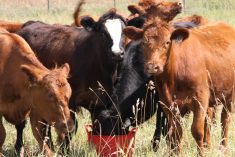With a name like Zink, the owner of Canada’s largest herd of Irish Kerry cattle occasionally wonders why he is trying to preserve the peasant cow of Ireland.
The primary focus of Colpitts Ranches is dairy and beef production. Yet just beyond the Holstein pastures, owner Joe Zink keeps about 30 black Kerry cows.
Registered as a rare breed, there are only 300 to 400 black Kerrys in Ireland. There may be 40 to 50 outside of Ireland.
“Compared to other breeds, I know virtually every cow in North America because there are so few,” said Zink, who owns the Calgary area ranch with his wife Kathy.
Read Also

Animal protection delivery to change in Saskatchewan
The Saskatchewan government is looking for a new agency to handle animal welfare after Animal Protection Services of Saskatchewan decided not to renew its contract next year.
He bought the cattle mostly from small holdings in Ontario eight years ago from people who kept them as a novelty animal. Others had one or two for milk.
The milk and cream from Kerrys do not separate because the fat globules are smaller than average.
Zink’s cattle descend from 12 Kerry heifers brought to Canada in 1971. Due to disease concerns, Ireland cannot export live animals. With some detective work, Zink has found enough live males and semen from unrelated bulls to expand his herd.
He now owns about 15 bulls and 30 cows.
He has recorded up to five generations of pedigrees on computer as a quick reference to avoid inbreeding.
He double registers his purebred Kerrys with the Irish breed society and Canadian Livestock Records in Ottawa. The Irish have registered these cattle for nearly 200 years so pedigree information extends through many generations.
While the money earners at Colpitts Ranches are the 150 Holsteins and 125 Herefords, the Kerrys have a unique place.
Descended directly from ancient cattle, they have characteristics that differ from anything else Zink has encountered.
They are agile, fleet footed and smart.They can be as wild as deer or as tame as a family dog.
Since Zink’s animals are rarely handled, they have retained many of their feral characteristics. Moving them requires careful planning.
Kerrys are completely black and grow long hair in winter that is shed off to a glossy coat in summer. They grow shiny upswept horns with black tips. Zink’s cattle are dehorned for easier management.
Like all breeders of unusual species, Zink is always looking for a practical application for these cattle. In Ireland, they are considered a dairy type.
“The only real useful thing I have come up with these is in a beef context, which is paradoxical,” he said.
He started breeding his Hereford heifers to Kerry bulls to produce Kerfords.
Calving is a breeze, with newborns weighing about 15 kilograms less than his Hereford calves. Heifers’ reproductive tracts are undamaged and can be easily rebred. The Kerry body conformation belies what is known about easy calving. The rump is narrow and yet birthing is without incident.
His Kerry bulls also produced some Kersteins by accident. The females produce less milk, but inherited the Holstein temperament.
He prefers the Kerford.
“It’s a very nice, utilitarian animal and it’s an opportunity to make a quantum leap in one generation to a Kerry type.”
The crossbreds go into the steer market and finish well as smaller framed beef cattle.
Fine boned with feminine faces, Kerry cows weigh up to 1,000 pounds depending on the environment. The bulls are larger and may not reach full maturity until they are five years old.
Kerry bulls occasionally throw red calves. These cannot be registered with the Irish Kerry Society. Only black animals with an optional patch of white on the udder are accepted.
The Kerry is believed to be one of the oldest breeds in Europe, descending from a Celtic Shorthorn introduced to Ireland by Neolithic man via Persia, Romania and Spain.
Starting about 1,000 BC, Irish peasants lived in their huts with these small, hardy cows. They used them to produce milk, cheese and butter.
Zink said preserving this old breed is a responsibility.
“As a connoisseur of cows and a breeder, I am interested in them. It’s interesting to see what a cow was like 1,000 years ago.
“The breeding of it has been very marginally affected.”
The farm website is www.colpittsranches.com.















